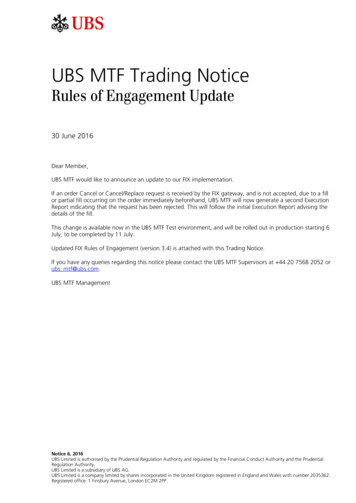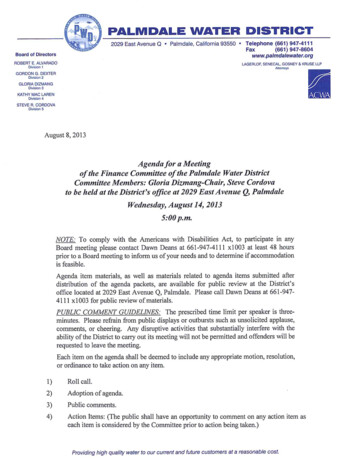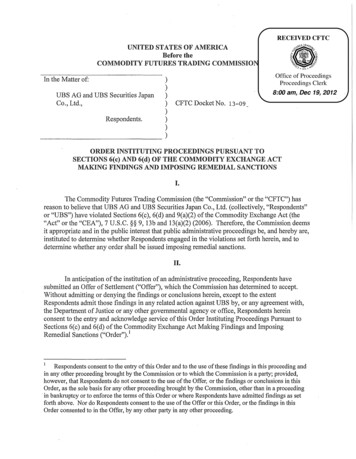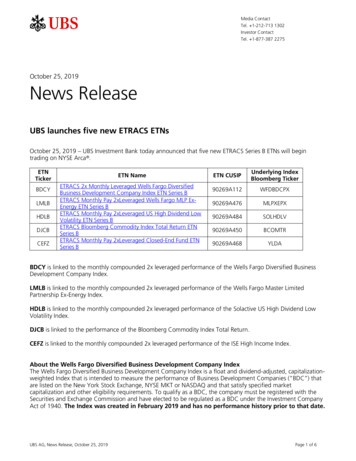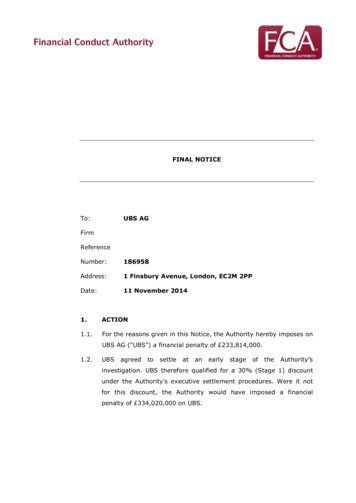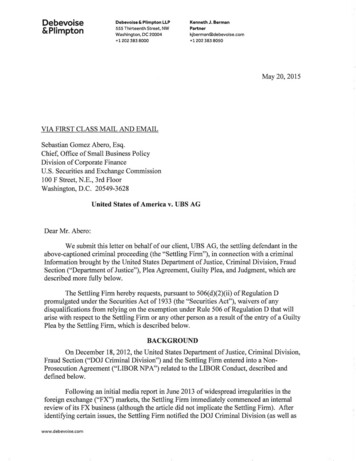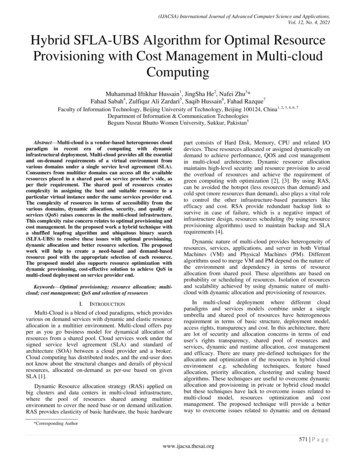
Transcription
(IJACSA) International Journal of Advanced Computer Science and Applications,Vol. 12, No. 4, 2021Hybrid SFLA-UBS Algorithm for Optimal ResourceProvisioning with Cost Management in Multi-cloudComputingMuhammad Iftikhar Hussain1, JingSha He2, Nafei Zhu3*Fahad Sabah4, Zulfiqar Ali Zardari5, Saqib Hussain6, Fahad Razque7Faculty of Information Technology, Beijing University of Technology, Beijing 100124, China1, 2, 3, 4, 6, 7Department of Information & Communication TechnologiesBegum Nusrat Bhutto Women University, Sukkur, Pakistan5Abstract—Multi-cloud is a vendor-based heterogeneous cloudparadigm in recent era of computing with dynamicinfrastructural deployment. Multi-cloud provides all the essentialand on-demand requirements of a virtual environment fromvarious domains under a single service level agreement (SLA).Consumers from multitier domains can access all the availableresources placed in a shared pool on service provider’s side, asper their requirement. The shared pool of resources createscomplexity in assigning the best and suitable resource to aparticular virtual instance under the same services provider end.The complexity of resources in terms of accessibility from thevarious domains, dynamic allocation, security, and quality ofservices (QoS) raises concerns in the multi-cloud infrastructure.This complexity raise concern relates to optimal provisioning andcost management. In the proposed work a hybrid technique witha shuffled leapfrog algorithm and ubiquitous binary search(SLFA-UBS) to resolve these issues with optimal provisioning,dynamic allocation and better resource selection. The proposedwork will help to create a need-based and demand-basedresource pool with the appropriate selection of each resource.The proposed model also supports resource optimization withdynamic provisioning, cost-effective solution to achieve QoS inmulti-cloud deployment on service provider end.Keywords—Optimal provisioning; resource allocation; multicloud; cost management; QoS and selection of resourcesI.INTRODUCTIONMulti-Cloud is a blend of cloud paradigms, which providesvarious on demand services with dynamic and elastic resourceallocation in a multitier environment. Multi-cloud offers payper as you go business model for dynamical allocation ofresources from a shared pool. Cloud services work under thesigned service level agreement (SLA) and standard ofarchitecture (SOA) between a cloud provider and a broker.Cloud computing has distributed nodes, and the end-user doesnot know about the structural changes and derails of physicalresources, allocated on-demand as per-use based on givenSLA [1].Dynamic Resource allocation strategy (RAS) applied onbig clusters and data centers in multi-cloud infrastructure,where the pool of resources shared among multitierenvironment to cover the need base or on demand utilization.RAS provides elasticity of basic hardware, the basic hardwarepart consists of Hard Disk, Memory, CPU and related I/Odevices. These resources allocated or assigned dynamically ondemand to achieve performance, QOS and cost managementin multi-cloud architecture. Dynamic resource allocationmaintains high-level security and resource provision to avoidthe overload of resources and achieve the requirement ofgreen computing with optimization [2], [3]. By using RAS,can be avoided the hotspot (less resources than demand) andcold spot (more resources than demand), also plays a vital roleto control the other infrastructure-based parameters likeefficacy and cost. RSA provide redundant backup link tosurvive in case of failure, which is a negative impact ofinfrastructure design, resources scheduling (by using resourceprovisioning algorithms) used to maintain backup and SLArequirements [4].Dynamic nature of multi-cloud provides heterogeneity ofresources, services, applications, and server in both VirtualMachines (VM) and Physical Machines (PM). Differentalgorithms used to merge VM and PM depend on the nature ofthe environment and dependency in terms of resourceallocation from shared pool. These algorithms are based onprobability or scheduling of resources. Isolation of resourcesand scalability achieved by using dynamic nature of multicloud with dynamic allocation and provisioning of resources.In multi-cloud deployment where different cloudparadigms and services models combine under a singleumbrella and shared pool of resources have heterogeneousrequirement in terms of basic structure, deployment model,access rights, transparency and cost. In this architecture, thereare lot of security and allocation concerns in terms of enduser’s rights transparency, shared pool of resources andservices, dynamic and runtime allocation, cost managementand efficacy. There are many pre-defined techniques for theallocation and optimization of the resources in hybrid cloudenvironment e.g. scheduling techniques, feature basedallocation, priority allocation, clustering and scaling basedalgorithms. These techniques are useful to overcome dynamicallocation and provisioning in private or hybrid cloud modelbut these techniques have lack to overcome issues related tomulti-cloud model, resources optimization and costmanagement. The proposed technique will provide a betterway to overcome issues related to dynamic and on demand*Corresponding Author571 P a g ewww.ijacsa.thesai.org
(IJACSA) International Journal of Advanced Computer Science and Applications,Vol. 12, No. 4, 2021resource provisioning with optimization and costmanagement. The proposed model also helps to avoid securityissue related to shared-pool of services in multi-cloud andhelpful for the new user to figure out basic concerns to adoptmulti-cloud services.Multi-cloud is an archetype that supports vendors toprovide services among various private and public cloudsholding any blend of these domains, e.g., heterogeneous cloudvendors, accounts, application, services, deployment, securitymodels, premises, regions, and availability zone. Theproposed model designed a hybrid algorithm with a shuffledleapfrog algorithm (SLFA) and Ubiquitous binary search(UBS). The design algorithm is helpful for optimization,energy saving, and QoS. In this research deployed a uniquealgorithm, e.g., genetic algorithm (GA), SLFA, and UBS. Theproposed design model shows better results in terms ofefficiency and cost-saving model with QoS.The research contributions are Define a new multi-cloud paradigm under IaaS toachieve optimal resource allocation. A hybrid algorithm to design the best selection andallocation of resources. Fulfill the need-based and demand-based requirementsof a virtual environment in multi-cloud. Achieve cost-optimized and efficient solutions in amulti-cloud paradigm using SLFA-UBS.This paper further contains three sections i) related workii) proposed work iii) optimal hybridization iv) result anddiscussion v) conclusion.II. RELATED WORKXiaoqun Yuan et al. [5] proposed a game theory that usedmath's strategies to draw the possible move and functionsusing Nash equilibrium. The accuracy of the activities makesmore chances to win. Each player strategy is the best responsefor others. The proposed theory depends on memory channelscheduling concerning time. The resource allocation inproposed model assign by using geo distribution with optimaldistribution. Mira Morcos et al [6] proposed a greedyalgorithm and Nash equilibrium technique for best resourceallocation with exponential time. Numerical analysistechnique performed form mobile computing network with forresource allocation and maximum cost saving.efficiency, accuracy, and QoS. J. Praveenchandar et al. [10]proposed an optimal model for dynamic resource allocationand cost-saving in a cloud environment with minimal powermanagement. The authors used a prediction-based dynamicresource table-updating algorithm in the proposed solution tosave optimal power. The proposed technique uses impressivetask scheduling and power utilization techniques.On-time deployment access control separation, direct andindirect trust between grid and cloud computing to avoidoverlapping and secrecy of credentials, data, and resources.[11] Open stack used on Linux based Xen and KVM machinesto extract there features on basic system level. System analysisengine SAE can investigate core resources like memory usageand optimization without any thread and handler. Discretefirefly algorithm applied to avoid side-channel attacks onshared resources to reduce malicious tenant access, energyconsumption, and resource loss on the provider end (DFAVMP) under IaaS [12]. All existing OS-based attacks work inthe same way; separate functionally of content reduce risks[13].Flora Amato et al. [14] stated data security validation andverification techniques using particular classificationalgorithms on databases. The thermal function used to classifysoftware and hardware classification. Saurabh Singh et al. [15]defined three tire security models related to embed systemarchitecture to achieve trust and VM migration from onesource to another associated strategies.Gururaj Ramachandra et al. [16] defined three attackvector networks, hardware, and hypervisor to retain thecomplexity of resource allocation and best utilization in aparticular virtual system. S Javanmardi et al. [17] proposedapplication-scheduling parameters in the cloud with fuzzylogic, genetic algorithms, and clustering techniques to achieveQoS in efficiency and throughput. The proposed work helpfulto meet the needs of resource pooling and allocation.Seyedehmehrnaz Mireslami et al. [7] defined a dynamicresource allocation technique on uncertainty-based algorithmsand optimization methods and saving total estimated cost. Theuncertainty proposed model provides dynamic resourceallocation with efficiency and accuracy in cloud infrastructureand deployment. Prasad Devarasetty [8] proposed need-basedresource allocation to implement a genetics algorithmtechnique with a particular defined budget to achieve QoS.The designed techniques deployed on amazon based cloudwith cost limitation and efficient resource allocation.K. Dinesh Kumar et al [18] proposed a resourceprovisioning model with cost saving strategies to avoid loss ofresources. A perdition method presented to avoid over costing,energy lost in data center, and cloud based environment, theproposed method predicted the basic need and upcomingstarvation of resources allocation and managed the load as perdefine perdition. The described techniques enhanced theaccuracy, correlation and utilization based perdition ofresources in cloud computing. Xiaolong Xu et al [19]presented a meteorological framework in cloud computingwith resource provisioning, flat tolerance and load balancing.In the proposed framework, virtual layer 2 further extracted todefine meteorological framework then a non-dominatedsorting algorithm applied to get load balancing with flattolerance. Xiaolong Xu et al [20] proposed an uncertaintybased software define framework form edge computing withbalanced resource provision and cost in term of energyconsumption. A multi-objective dynamic allocation withbalanced scheduling techniques adopted to achieve energyefficient and cost effective dynamic resource provision andallocation in fog computing environment.Lailan M. Haji et al. [9] described various techniques fordynamic resource allocation in a cloud environment to achieveCloud computing is multitier, highly scalable, and pay-peruse-based model over the internet; due to this nature, virus,572 P a g ewww.ijacsa.thesai.org
(IJACSA) International Journal of Advanced Computer Science and Applications,Vol. 12, No. 4, 2021Trojans, and spy are the types of inherited attacks categorizedas i) Cloud malware Injection: inject some malwareapplication, service, or VM based machine in Cloudcomputing [21]. ii) Metadata spoofing: modify metadatainformation [22]. Younis A. Younis et al. [23] describe othersecurity-related challenges like SLA Monitoring, managementand risk analysis, heterogeneity, virtualization, trust, accesscontrol, identity management (IDM), and cross-organizationmanagement.generated in a real time-based scenario, depending on the UBSsearch algorithm. The diagram ―Fig. 1‖ elaborates therelationship between optimization and classification of theproposed dynamic resource allocation technique.B. Asvija et al. [24] describe hypervisor basevulnerabilities with the use of a designed framework based onCPU, memory, and I/O firework in virtualization. Someattacks justified by the proposed technique, like GPU-basedside-channel attacks, I/O channel attaches and shared memoryside-channel attacks in a shared pool of resources. There willbe risk analysis to analyze the performance and deficiency indeployment and measuring security traits. SVM is used togather the possible online attack over the cloud nodes on ahypervisor level by using parameters system and networklevel utilization. This approach consists of detect, remediate,recover, and defend process steps and will be able to improve90 percent in malware and DOS detection [25].III. PROPOSED WORKIn the proposed research, in proposed technique presenteda hybrid optimization and classification algorithm for dynamicresource allocation in a multi-cloud paradigm. This hybridalgorithm is a combination of (shuffled leaf frog algorithm)SLFA with (Ubiquitous Binary Search) UBS and puregenetics theories. SLFA analyzes all the available resourcesfrom shared pool in the multi-cloud and divides them intosmall groups. Resources from these small groups are selectedon need-based and demand-based. Need-based resources areused to complete the initial requirement of each virtualinstance. Demand-based resources are required to complete aspecific task on a particular VM instance, where needed a fulloptimization with cost efficiency. Therefore, can be borrowedthe resources to meet the runtime need from VM in the samepool or from shared pool. These borrowed resources will bereturned back after completion of the task. The proposedtechnique ensured the optimal utilization of demand-basedresource with minimal cost.A small group of resources created on factors likeefficiency, throughput and cost in terms of energy-efficientmode. However, to find the best and a reliable resource poolin the defined mechanism depends on two different searchmethods internal (need-based) and external (demand base)search. UBS algorithm is used to achieve the best performanceand minimum cost to search from everywhere with efficacyand availability of required resource pool for a specific VM ina multi-cloud environment. The flow chart in "Fig. 1‖presented the detailed relationship of SLFA and UBSalgorithm to attain optimization.The particular VM generates resources demand requestfrom a shared pool based on the following equation.VRp (x) {vRp1, vRp2, vRp3, . . . ,vRpn}Where VRp (x) presents the number of requests from anyVM and x may be any real number from 1 to n. The requestFig. 1. UBS and SLFA Optimization Framework Flow Chart.IV. HYBRID OPTIMIZATION AND CLASSIFICATIONHybrid optimization depends on the deployment of SLFAand UBS in multi-cloud. This combination provides optimaldynamic resource allocation from a shared pool [26]. Thehybrid deployment provides the best-optimized solution ascompare to prior scheduling and scaling techniques. In thissection, this technique presented a deployment of SLFA, UBS,GA, and hybrid SLFA.A. Shuffled Leapfrog AlgorithmIn the formation of subgroups, must know about thenumber of groups and the number of resources in each group.If the number of groups and the number of each type ofresources in the group can be considered as one, the totalresources will be T G*R. The number of best utilization ofresources depends on the cost function of each group withoptimal value. The whole resources divided into smallcategories; e.g., each type of resource must be in a group tofulfill need-based allocation.In the division, choose the first member from the firstcategory and second member from the latter category of theresource until the poll completes and add into G. Aftercompletion of the division, external search of a particularresource pool will start [27].573 P a g ewww.ijacsa.thesai.org
(IJACSA) International Journal of Advanced Computer Science and Applications,Vol. 12, No. 4, 2021B. External ResearchThe metadata exploring process of the resources dividedinto two main stages external and internal. This step involvesselecting the best optimal pair of resources to complete theinitiated request involve the following steps.Step 1: Initialization: select G and R, where G represents asmall group of resources and R the number of resources. Sothe total number of groups with complete resources will be.T G*RStep 2: Reproduction of Virtual groups: For the availableresources, the sample of S virtual resources will be v(1), v(2) . V(s).V(i) {vi1, vi2, , vid} where d present the matter ofdecision and selection of particular resource in the group.Step 3: Section and sorting: Sort the resources indescending order in a particular group. Then complete groupwill be v(i), s(i) and i 1 to s. the best place of theresources is (v Px(i)).Step 4: Division of resources into groups: Divide array Xinto Y that each of them obtains N resources.Step 5: Resource evaluation in each group: Each Yk wherek 1,2,3 G in each group assessed by the internal searchgiven bellow.Step 6: Combination of groups: After the evaluation, eachgroup contains (Y1 YG) the number of each type ofresource for a specific pool.Step 7: If the convergence conditions meet, then stop else;go to the fourth step of external research.C. Internal ResearchIn the 5th step of the external search, the selection of groupperformed N time independently. After the completion of thesearch mechanism, the algorithm will return to global researchto complete the step. Internal research steps are as follows.Step 1: Set iG and iN to zero. Where iG counts the numberof groups and iN counts the progression steps.After reassigning value to a particular resource, if itsefficiency is better than the previous one, it can be replacedwith the previous one's value. Otherwise, go to the next step ofinternal research.Step 7: If the new value of the resources is not accordingto the given need, then randomly generate a new virtualresource and replace that particular resource with a randomlygenerated new virtual resource in the pool.Step 8: Update the group: After changing the value of thelowest resource with the newly virtually generated resource,sort them in descending order with the UBS algorithm's help.Step 9: if N iN perform step three of the internal searchagain.Step 10: if G iG goes to step 1 of internal search,otherwise return to the external search to combine the groups.D. Ubiquitous Binary SearchUBS is all aware of the binary search algorithm, verycomplex to resolve the required query. Binary searchalgorithm always follows a sequential search pattern, so it isvery costly and complex to get output. The cost of thealgorithm is highly concerning the complexity of the searchscenario. UBS can search everywhere, anytime, with anysequence from any medium or device. Hence, it is very helpfulto implement in current distributed nature infrastructure likemulti-cloud. In our proposed model, UBS used with no loopsand no equal check. Like can find the required output by using and , which is very helpful to reduce review and loopsand increase the efficiency of the algorithm with low cost. Thelow and high method or use to select with an appropriateresource for the best selection in low will always less thanhigh and a mid to calculate the average. The cost of thealgorithm will be lg(n).def ubiquitous binary search(a,key) # a is the array and key isthe value we want to searchlo 0hi a.length-1while(hi-lo 1)mid lo (hi-lo)/2Step 2: 1 iG iGStep 3: 1 iN iNStep 4: Creation of subgroups: The creation of subgroupsrelated to higher value associated with best one and lowervalue associated with a lower one. Value is assigned with thehelp of triangular probability distribution.Step 5: Correction of the worst position: This is calculatedby combining the lowest associated probability and selectionleap parameter if the resource e.g., Ram, has the lowestcapacity than the needed one. Now, if reassigned the value toa particular resource, then in the best case, go for step 8 of theexternal search; otherwise, go to step 6 of the externalsearches.Step 6: calculate the resource size with the best-assignedvalue. If results obtained from step 5 are not better, then thesize of the particular resource can be calculated as efficiency.if a[mid] keylo midelsehi midendendif (a[lo] key)return loelsereturn "value not found"endend574 P a g ewww.ijacsa.thesai.org
(IJACSA) International Journal of Advanced Computer Science and Applications,Vol. 12, No. 4, 2021E. Genetic AlgorithmsGenetic algorithms are used in natural section techniquesto sort out complex problems. These algorithms define a givenproblem as a string in the workspace and find the result withcore gentian parameters in that give model.GA algorithms are probabilistic and use natural evaluationin the propagation of results. The population of biologicalmetrics like chromosomes used as an idle parameter toemulate GA algorithms. As the different types of resources ina resource pool, select and the best match one to overcomedemand-based and need base requirements of a particularsystem in a multi-cloud architecture. Nature resourcesparameters are used to emulate and propagate the best resultsin the selection pool.F. Hybrid SFLA and UBSIn the hybrid proposed solution, SFLA used with UBSqualities together and founded better results. The proposedhybrid algorithms showed more throughput, efficiency, andcost savings in terms of execution time and turnaround time.UBS used as a searching algorithm to find the best resourcefor selection and get a better combination of need-based anddemand-based requirements. The proposed model helpful tochoose the best appropriate resource to fit in the required needof a specific VM in multi-cloud infrastructure deploymentwith hybrid vendor-based architecture.The proposed model described in the form of flow chartbased implementation in ―Fig. 2‖.The cost of this hybrid model in term of execution timeand turnaround time calculated as Worst case time: Ø lg(n). Average case time: Ø (1). Average case time: Ø lg(n).Therefore, gain efficacy and energy-saving model by usingthe proposed hybrid algorithm for dynamic resource allocationin multi-cloud.Fig. 2. Hybrid SLFA and UBS Proposed Model Flow Chart.575 P a g ewww.ijacsa.thesai.org
(IJACSA) International Journal of Advanced Computer Science and Applications,Vol. 12, No. 4, 2021V. RESULTS AND DISCUSSIONIn the proposed model throughput, Turnaround time, andexecution time as metrics to evaluate the QoS and cost of thedesign algorithm.A. ThroughputThroughput is maximum output at a certain time for aspecific hardware type. It is performance measure of basicresources such as RAM, Hard drive, and CPU in a sharedresources pool [28]. The throughput calculated asTt It /tAccording to the statistics shown below diagram, Ttpresents the maximum output of a certain resource at aspecific time. It is the peak value of resource under time unit"t." Results shown that the proposed hybrid algorithm presentmaximum throughput, which helps to create and maintain acomplete resource group according to the given need. Thethroughput values taken at the point where maximum numberof task executed by each algorithm individual. In designedcase, the maximum number of tasks up to 300. The graphicalpresentation of different algorithms with respect to times persecond is illustrated in ―Fig. 3‖. Where ―Table I‖ presented thenumeric values of throughput in terms of per second.B. Turnaround TimeTurnaround time presents the maximum amount of timefrom submitting a specific task, and its output returns to theuser. It totally depends upon the function used by thedeveloper in the code. Hence, UBS performed with lessturnaround and execution time due to the absence of loopcomplexity in generic binary algorithms [29]. It can becalculated asT(t)avg C(t) –A(t)80THROUGHPUTWhere T(t)avg presented average turnaround time withCT, total execution time and A(t) time of arrival of a specifictask. ―Table II‖ described the turnaround time as per numberof tasks for each algorithm.Results showed that the hybrid SLFA-UBS algorithmperforms continually constant with the increase of the numberof tasks on the horizontal axis. The proposed model is muchefficient to resolve maximum number of tasks in lessturnaround time as shown in the ―Fig. 4‖.C. Execution TimeTotal time requires executing a certain task as per user’sdemand. The execution time of SLFA-UBS is less, as compareto individual performances of every algorithm shown in―Table III‖ and ―fig 5‖ respectively. Execution time can becalculated asE(T) E(t) – F(t)Where E(T) presents the computational time required toexecute a specific task, E(t) ending of the task, and F(t) is thebeginning of a specific task by the user. With respect to thenumber of tasks over total time to execute, SLFA-UBSperforms better than any individual algorithm.TABLE II.TURN AROUND TIME COMPARISONNumber of 391520025304015250263141173002732421771Time (Sec)6040514537200SLFAUBSGAAlgorithms NamesSLFA-UBSFig. 4. Turnaround Time Graph.Fig. 3. Throughput Graph.TABLE I.TABLE III.THROUGHPUT ON A CERTAIN DEFINE POINT WITH MAXIMUMNUMBER OF TASKS 300EXECUTION TIME COMPARISONNumber of tasksSLFAUBSGASLFA-UBS501917157NameTime A5125034353818SLFA-UBS7130037394420576 P a g ewww.ijacsa.thesai.org
(IJACSA) International Journal of Advanced Computer Science and Applications,Vol. 12, No. 4, 2021[5][6][7][8][9][10][11]Fig. 5. Execution Time Graph.VI. CONCLUSION[12]In the multi-cloud deployment dynamic resource allocationand best resource selection for particular virtual machine tofulfill the need-based resources requirement is a big challenge,and creates an adequate concern for cloud services providers.Resource optimization with minimal computational cost andthroughput is also a rising concern with respect to betterresource allocation in multi-cloud environment. SLFA-UBSproposed algorithm used to resolve the problems related tooptimization and cost management in the selection ofparticular need-based resources from a shared pool in a multicloud paradigm. Execution of the proposed model used―CloudSim‖ to simulate and extract the results. The resultsshowed that the throughput of the proposed model is 60%better than a single individual algorithm. The turnaround timeand execution time had very few seconds variations near toconstant as per increase in the number of tasks.The proposed work ensured resources optimization withthe dynamic provisioning techniques in the multi-cloudenvironment. Cost efficiency and quality of services alsoobtained in the summarization of this research work. Hence,we concluded that our proposed SLFA-UBS algorithmobtained better performance in optimal dynamic resourceprovisioning with QoS and low cost. In the future we extendour work to real time deployment of designed algorithm oncloud service providers end to enhance the archived results intest environment.[1][2][3][4]REFERENCESKumar, R., & Goyal, R. (2019). On cloud security requirements, threats,vulnerabilities and countermeasures: A survey. Computer ScienceReview, 33, 1-48.Diouani, S., & Medromi, H. (2018). Green cloud computing: Efficientenergy-aware and dynamic resources management in data centers.International Journal of Advanced Computer Science and Applications,9(7), 124-127.Ahmad, I., & Chang, K. (2020). Mission-critical user priority-basedcooperative resource allocation schemes for multi-layer next-generationpublic safety networks. Physical Communication, 38, 100926.Suresh, A., & Varatharajan, R. (2019). Competent resource provisioningand distribution techniques for cloud computing environment. ClusterComputing, 22(5), 2][23][24]Yuan, X., Min, G., Yang, L. T., Ding, Y., & Fang, Q. (2017). A gametheory-based dynamic resource allocation strategy in geo-distributeddatacenter clouds. Future Generation Computer Systems, 76, 63-72Morcos, M., Chahed, T., Chen, L., Elias, J., & Martignon, F. (2018). Atwo-level auction for resource allocation in multi-tenant C-RAN.Computer Networks, 135, 240-252.Mireslami, S., Rakai, L., Wang, M., & Far, B. H. (2019). Dynamic cloudresource allocation considering demand uncertainty. IEEE Transactionson Cloud Computing.Devarasetty, P., & Reddy, S. (2019). Genetic algorithm for quality ofservice based resource allocation in cloud computing. EvolutionaryIntelligence, 1-7.Haji, L. M., Zeebaree, S. R., Ahmed, O. M., Sallow, A. B., Jacksi, K., &Zeabri, R. R. (2020). Dynamic resource allocation for distributedsystems and cloud computing. TEST Eng. Manag, 83, 22417-22426.Praveenchandar, J., & Tamilarasi, A. (2020). Dynamic resourceallocation with optimized task scheduling and improved powermanagement in cloud computing. Journal of Ambient Intelligence andHumanized Computing, 1-13.Kaur, S., & Bhushan, R. (2013). Review Paper on ResourceOptimization of Servers using Virtualization. International Journal ofAdvance Research in Computer Science and Software Engineering, 3,327-332.Ding, W., Gu, C., Luo, F., Chang, Y., Rugwiro, U., Li, X., & Wen, G.(2018). DFA-VMP: An efficient and secure virtual machine placementstrategy under cloud environment. Peer-to-Peer Networking andApplications, 11(2), 318-333.Mohd Hairy Mohamaddiah, Azizol Abdullah, Shamala Subramaniam,Masnida Hussin ―A Survey on Resource Allocation and Monitoring inCloud Computing‖, International Journal of Machine Learning andComputing, Vol. 4, No. 1, February 2014.Amato, F., Moscato, F., Moscato, V., & Colace, F. (2018). Improvingse
(UBS). The design algorithm is helpful for optimization, energy saving, and QoS. In this research deployed a unique algorithm, e.g., genetic algorithm (GA), SLFA, and UBS. The proposed design model shows better results in terms of efficiency and cost-saving model with QoS. The research contributions are

